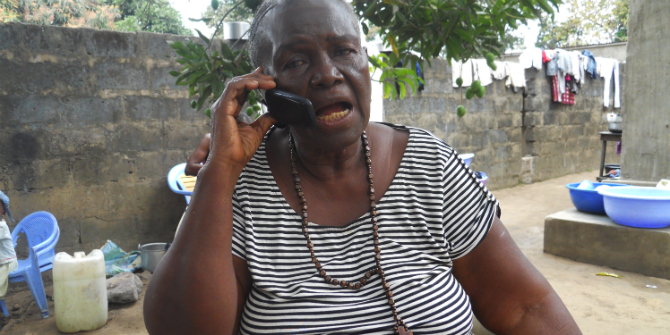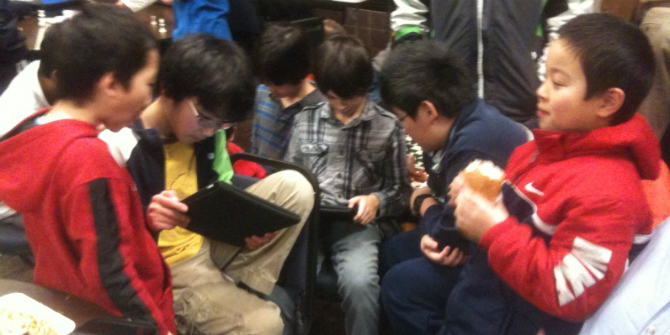 The Everyday Schooling in the Digital Age project carried out an in-depth ethnography of the realities of digital technology across three contrasting Australian high schools. In the second of two posts, researcher Dr Selena Nemorin discusses how digital technology can be better used to improve communications between home and school, and support students’ learning in both environments. Selena Nemorin is a lecturer in sociology of digital technology at the University College London. Her research interests include critical theories of technology, surveillance & society, data/IoT ethics, and youth and new media/technologies. [Header image credit: T. Warren, CC BY-NC 2.0]
The Everyday Schooling in the Digital Age project carried out an in-depth ethnography of the realities of digital technology across three contrasting Australian high schools. In the second of two posts, researcher Dr Selena Nemorin discusses how digital technology can be better used to improve communications between home and school, and support students’ learning in both environments. Selena Nemorin is a lecturer in sociology of digital technology at the University College London. Her research interests include critical theories of technology, surveillance & society, data/IoT ethics, and youth and new media/technologies. [Header image credit: T. Warren, CC BY-NC 2.0]
Research suggests that positive communication between families and schools correlates with students’ academic achievement as well as their social and emotional development. However, as my first post suggested, there is a disconnect between home and school in terms of interpersonal communications mediated by digital technology.
The two vignettes in my first post, ‘Digital technology in school fails predictably – but is mandated anyway. Part One: Understanding the problem’ illustrated that this mode of communication has, at times, led to negative experiences in the home. They also raised questions about where the boundary between school and home lies, as digital technologies extend schools’ reach well beyond the physical enclosures of the campus.
Here, digital networks stretched beyond the material locality of the classroom, demonstrating a continuous architecture that left an impact in multiple locations. The mechanisms built into these technologies allowed student analytics to be available in real time. This connectedness had teachers not only monitoring students doing their homework during after school hours, but also having communicative access to students 24/7.
Such reach, particularly in light of the instantaneous nature of sending messages back-and-forth, occasionally resulted in emotional flare-ups at night and over the weekend between teachers, students, and parents.
In this capacity, communication between school and home had become events where the norms of civility were tested and sometimes transgressed, illustrating how tensions were growing alongside the increased use of digital technologies in school.
So, what might be done differently?
Preliminary ideas
As others have suggested, it is important that the gap between home and school is bridged. There are at least two primary reasons for this: to stimulate a better understanding of the nature and processes of digital technologies in school and their implications for the home, and to encourage parental participation in decisions around how digital technology ought to be used by the school community, thereby contributing to a more democratic form of school governance. What follows are a few thoughts on possible ways forward.
1. Work mindfully to close the communication gap between school and home.
There are a number of ways to organise and manage digital technology in schools that attend to the values and goals shared across school and home.
An area to explore as a starting point for bridging the gap between home and school is the possibility of more democratic organisation of decisions around school technology use.
This begins with school staff understanding the culture and needs of the students and families with whom they work. It also requires cooperation between teachers, parents, students, as well as the providers of educational technology tools.
Tools should support a more natural communication flow between the institution and parents, and should be accompanied by clear policies which are always mindful of the rights and reasonable expectations of privacy and civility of all parties.
2. Encourage parental participation in decisions around how digital technologies ought to be used in the wider school community.
Helping parents and families become more actively engaged with school technology use is not straightforward, but undoubtedly involves increased dialogue and shared decision-making.
It is reasonable for parents to expect to be kept informed about how new technologies are being used, and whether or not these technologies are actually contributing to the well-being and academic success of their children. It is also reasonable for parents to discuss with school staff their own expectations around how digital technologies ought to be used.
What works for the school may not always work for parents, and vice versa, and misunderstandings arise when processes are unclear. A more democratic approach to school governance could seek to close the space in which misunderstandings can flare up.
With this in mind, schools need to be very clear about the policies and processes attached to whichever platforms they intend to incorporate into everyday schooling.
3. Both teachers and parents have a responsibility to raise children’s digital literacies.
Much has been written about communications in the workplace, but nothing particularly helpful for students who have to micro-manage the possibly contradictory demands of parents and teachers.
Dialogue must not simply be enacted between the home and school, between parents and teachers; it is also important for parents to take the time to discuss the benefits and challenges of school digital technology use with their children, and for teachers to explicitly engage in these conversations with their students to make sense of what students actually need to facilitate learning.
This process is grounded on giving all voices a role in determining and discussing what digital education is, its implications, and what it should be.
4. Students should be encouraged at home to support and enhance their learning through innovative use of technologies.
Too often, we observed that classroom-mandated technology platforms did not necessarily engage students or enhance their learning. That said, students were engaging deeply with their learning via other forms of technology they had discovered independently.
Following on from the previous point, discussions about, and explorations of, innovative use of technologies as aids for learning should also be enacted at home. This has the potential to help parents better understand the educational experiences of their children.
5. Accountability with participation
The power to make decisions about technology use in school should be publicly legitimated, and school decision-makers held accountable to both students and parents. Educators have the responsibility to help families access high quality and trustworthy educational technology products that serve student interests.
Additionally, educational technology companies must be transparent about their products. As such, these companies need to be held responsible for ensuring schools and families properly understand the constraints, opportunities, and consequences of use of their products, especially with regards to issues around privacy and protection of student data.
With accurate and rich information derived from involvement in school discussions, parents can make better decisions for their children. This has the potential to lead to configuring digital technology use in ways that are sensitive to the needs of local school communities, and working to develop technology products and practices from within a school, rather than importing them as a one-size-fits-all solution from outside the local school context.
Concluding thoughts
Some readers might find these suggestions of little surprise. The three schools which were studied, Lakeside, Mountview, and Middleborough, were indeed doing the best they could to work through the day-to-day pressures of digital technology use, but sometimes the unintended consequences of these new technologies would prove overly challenging.
Within these challenges, however, were possibilities that could be harnessed for positive change. Acting on these moments for change, however, would entail stepping back from rushing to bring new technologies into the school simply for the sake of ‘innovating’, and pausing to make sense of the complex realities of each educational technology solution.
Schools need to ensure that they can deliver on the ‘promise’ of digital technologies to the benefit of students. Additionally, parents have the right to be kept informed about school technology use and/or actively involved in the decision-making process regarding such use. After all, informed and engaged parents are better equipped to ensure their children have access to meaningful educational experiences.
This post gives the views of the authors and does not represent the position of the LSE Parenting for a Digital Future blog, nor of the London School of Economics and Political Science.





